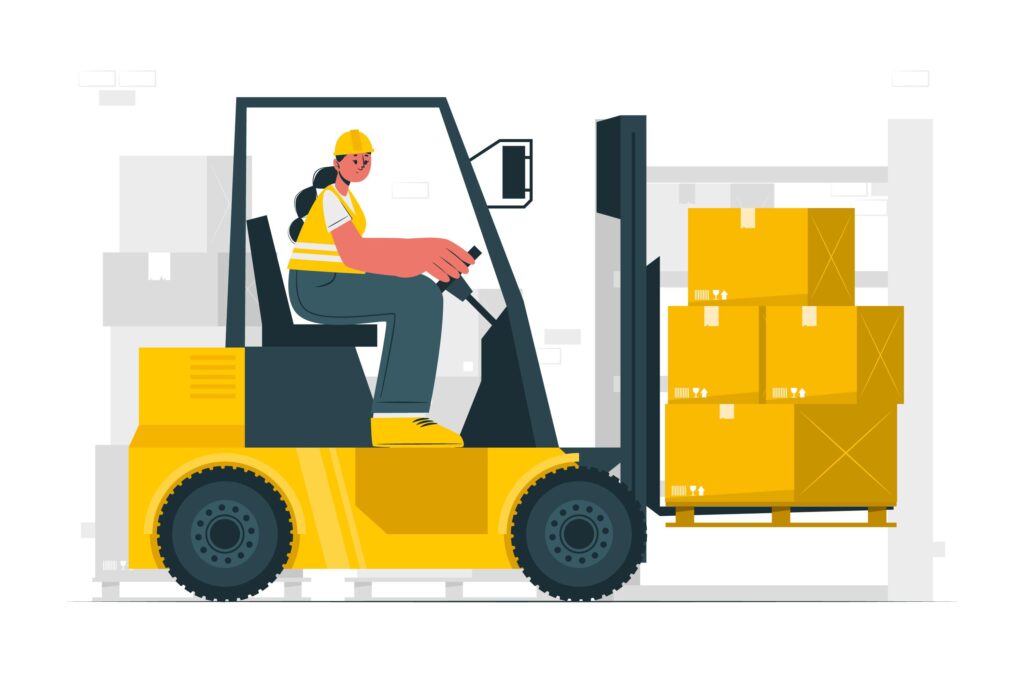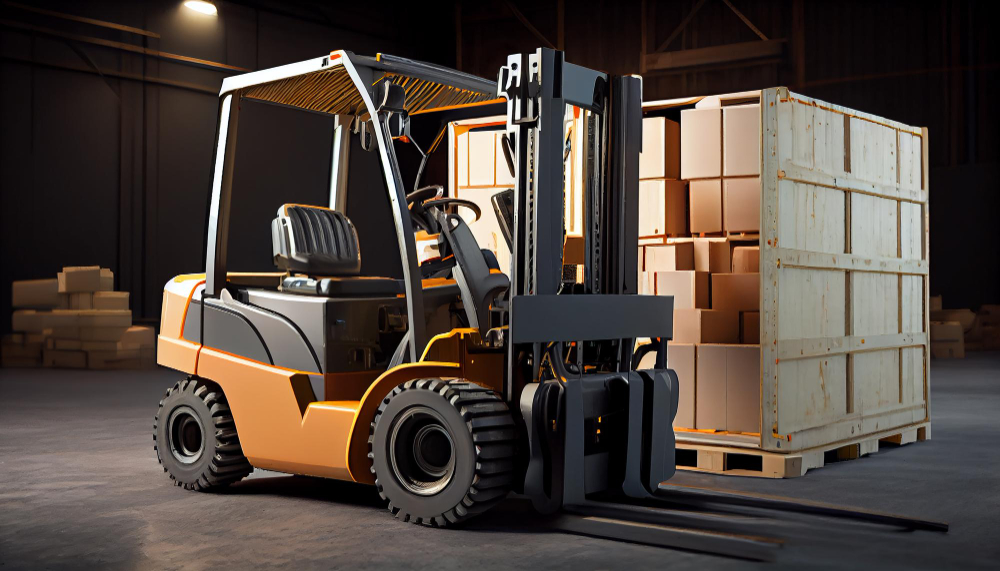Many different businesses rely heavily on forklifts. Moving large quantities in warehouses, building sites, and other environments calls for them as well.
But a forklift can only lift how much?
The question is more complicated than first appears. Several elements strongly affect forklift capacity. These cover the kind of forklift, its design, and the operating circumstances.
One must understand forklift capacity. It guarantees effective and safe running conditions, therefore avoiding mishaps and damage to products.
In this guide, we’ll delve into the intricacies of forklift capacity. We’ll explore factors that affect it, different types of forklifts and their capacities, and how to operate a forklift safely within its capacity limits.
The article will offer insightful analysis regardless of your position—that of forklift operator, warehouse manager, or just interested. Let us begin now.
Understanding Forklift Capacity
Forklift capacity refers to the maximum weight a forklift can safely lift. This number is typically displayed on the forklift’s data plate. It is a crucial aspect of forklift operations because it helps prevent overloading and ensures safety during material handling.
A normal forklift can typically raise three thousand to five thousand pounds. Light industry environments and warehouses abound with these models. By comparison, heavy-duty forklifts such as the Taylor GT 210 have capabilities more than 35,000 pounds. Industries needing transporting very big or massive loads are fit for such equipment.
Many elements affect the lifting capability of a forklift. These cover the type of attachments utilized, lift height, and load center.
- Load Center: The distance from the fork’s face to the load’s center of gravity.
- Lift Height: The height to which the load is lifted affects stability.
- Attachments: Can alter the original capacity of the forklift.
Selecting the correct forklift for the job depends on an awareness of these elements. It guarantees both safety and efficiency of operations. Knowing these components improves planning and helps to avoid mistakes when forklift operating.
The Role of the Data Plate in Forklift Capacity
Every forklift has a data plate loaded with essential information. Often placed in the operator’s compartment, this metal panel notes the lift height, load center, and forklift capacity. For operators to grasp the limits of the equipment, this is a must-have manual.
Following manufacturer requirements given on the data plate is really vital. These features guarantee the forklift’s safe running. A basic habit for operators is to operate within these constraints as it helps avoid equipment damage and mishaps.
Ignoring the data plate information could have serious results. Overloading the forklift outside of its recommended capacity could cause equipment breakdown or tipping. Consulting the data plate is therefore not only advised but also a safety need. It is a constant regulation for preserving not only forklift safety but also its lifetime.
Calculating Forklift Capacity with Attachments
Original capacity of a forklift may be greatly changed by attachments. Side-shifters or longer forks add weight distribution and load center adjustment. These adjustments can lower the forklift’s maximum safe lifting capacity.
You must have accurate data if you want to correctly estimate the increased capacity including attachments. Determine first the weight and extra load center changes of the attachment. These figures will let you change the capacity of the forklift so it stays safe for daily usage. Ignoring to change the capacity could cause mishaps or malfunction of the device.
Making capacity modifications benefits from a checklist creation. Think about the next actions:
- Identify Attachment Weight: Know the weight of your new attachment.
- Check Data Plate: Look for the machine’s base capacity details.
- Consult Manufacturer or Calculator: Use manufacturer data or a forklift capacity calculator for precise adjustments.
Regularly reassess capacity after any equipment changes. Keeping these calculations up-to-date ensures operational safety and efficiency.
Load Center and Lift Height: Key Factors in Capacity
A basic idea in forklift capacity is the load center. It speaks about the horizontal distance from the vertical face of the forks to the center of gravity of the load. Although a normal load center is 24 inches, the weight distribution and size of the load will affect it. Correct knowledge of this idea guarantees the forklift runs within reasonable limitations.
The lifting capability of the forklift falls as the load center rises. This is so as the weight of the load moves forward and additional counterbalancing force is needed. Keeping the correct load center guarantees the forklift can manage the load safely and helps prevent tipping mishaps. Ignoring load center issues might cause instability and maybe accidents.
Stability and capacity of a forklift also depend much on lift height. The center of gravity shifts when a forklift raises a load, therefore influencing its balance. Higher height lifting calls for great attention to guarantee safety. Greater heights cause the machine to become more prone to tipping, therefore reducing its effective capacity.
To optimize safety and operational efficiency, consider these key points:
- Know the Load Center: Always measure and understand your load’s center.
- Adjust Forks Appropriately: Keep loads centered and forks adjusted to maintain balance.
- Monitor Lift Height: Remain cautious as lift height increases to sustain stability.
Safe forklift operation depends on an awareness of the link among load center, lift height, and stability. In warehouse settings, correct training and awareness may greatly increase efficiency as well as safety.
Safety Tips for Operating at Maximum Capacity
Running a forklift at maximum capacity calls for accuracy and care. Following safety criteria guarantees the integrity of the load as well as the operator’s safety. Safe and competent forklift use depends on awareness and training. Confident navigation of maximum loads by a well-trained operator preserves control and stability.
One has to be aware of the restrictions of the forklift. Beyond weight capacity can have serious results. Overloading reduces stability and raises accident risk by tipping. It can also tax the parts of the forklift, causing mechanical problems. These hazards underline the need of honoring capacity restrictions.
Here are practical tips for safe operation:
- Check the Capacity Chart: Always verify capacity before lifting.
- Balance Loads Properly: Ensure even weight distribution to prevent shifts.
- Move Slowly: Navigate cautiously to maintain control over heavy loads.
Safe forklift operating at maximum capacity is significantly influenced by awareness and planning. Respect of weight constraints and adherence to policies help operators to guarantee effective material handling as well as their safety.
Maintenance and Inspection: Ensuring Capacity Integrity
The capability of a forklift depends on regular maintenance. Regular maintenance helps to avoid wear and tear damaging lifting capabilities. Maintenance tasks include tire, brake, and hydraulic system inspection to guarantee each component runs as it should.
Maintaining capacity integrity also depends much on inspections. Regular inspections assist to find possible problems early on. Inspections should cover looking at the mast, forks, and any utilized attachments. This proactive technique fixes issues before they could compromise performance. Comprehensive examination guarantees the forklift runs within its intended range.
Verification of the lifting power’s constantity depends on capacity tests. Analyzing variables like tire pressure and oil levels helps to stop capacity loss. Ensuring that every component is in good shape helps operators to maintain safety criteria. Regular maintenance and inspections guarantee the forklift’s capability, therefore enabling effective and safe operations.
Forklift Types and Their Capacities
Effective material handling depends on the correct type of forklift used. Various capabilities of different forklifts depend on tire type and fuel supply. Knowing these variations will enable one to make wise judgments for certain activities and surroundings.
Pneumatic and cushion tires affect a forklift’s lifting capacity. Usually air-filled, pneumatic tires are good for uneven outdoor surfaces. Their increased grip and stability might help to support additional capacity. On smooth floors, cushion tires—which offer better mobility indoors—are perfect. They may, however, restrict capacity relative to pneumatic choices.
Fuel type influences lifting power of a forklift even more. Quieter and with no emissions are electric forklifts. For modest capacity indoor usage is preferable. Greater lifting capacity and fit for heavy-duty outdoor chores come from diesel-powered vehicles Propane forklifts balance use indoors and outdoors with an acceptable capacity.
Models of heavy duty like the Taylor GT 210 forklift shine in demanding settings. Thanks to its strong construction, this forklift can raise really large weights. Perfect for businesses needing extraordinary lifting capability, like freight and construction. Forklifts such as the Taylor GT 210 draw attention to the significance of choosing a model with the right capacity for your requirements.
Legal and Training Considerations for Forklift Capacity
Operating a forklift depends on following legal criteria. Many times, rules call for the usage of forklifts inside designated capacity limitations. Ignoring rules could result in fines or mishaps, therefore affecting worker safety and business operations.
Making sure operators grasp forklift capability depends on training. Programs for thorough instruction address safe lifting procedures, weight distribution, and capacity restrictions. Operators have to understand the need of following rules in order to guarantee steady operation and avoid overloading.
Certified individuals also help to create a safer workplace. Good training enables them to see possible problems, including unbalanced loads, which may cause a forklift to become unstable. Stressing lifelong learning guarantees operators stay current on best practices, hence improving both safety and efficiency.
Maximizing Efficiency and Safety
Safe and effective operation depend on an awareness of forklift capacity. Among the important lessons is understanding how attachments and lift height influence capacity and its determinability. By means of consistent maintenance and comprehensive operator training, one may avoid mishaps and prolong equipment lifetime.
Although they are strong instruments, their true value only comes from proper use. Keeping within capacity guarantees stability and helps to avoid expensive mistakes. Respecting these rules helps companies increase safety and production, optimizing the working conditions for all those engaged.



